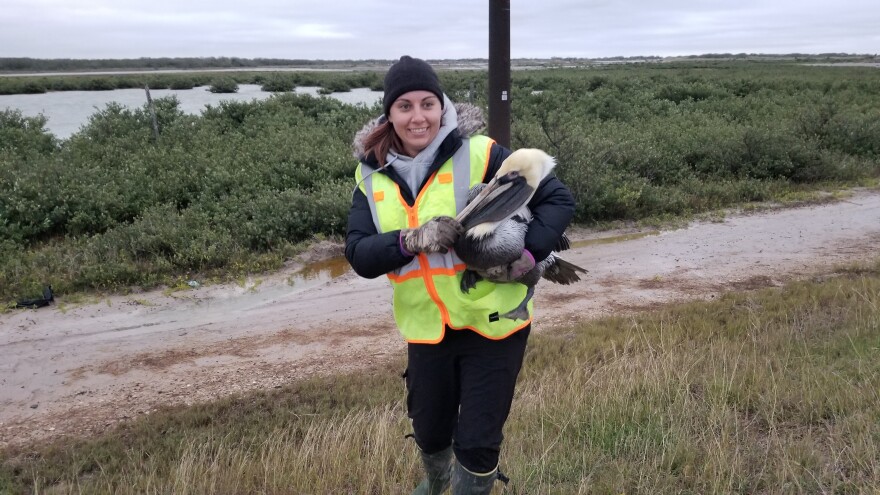From Texas Public Radio:
Pelicans are continuing to drop out of the sky on a highway outside of Brownsville.
A volunteer team ventured out to State Highway 48 on Thursday afternoon, hoping to recover pelicans struggling to cross the Joseph “Joe” Gayman Bridge in the strong winds that came with this week’s freezing temperatures.
Stephanie Bilodeau, a conservation biologist with the Coastal Bay & Bend Estuaries Program (CBBEP) who heads the volunteer team, was the first to arrive. By the time she got there, one pelican had been killed just up the road, at the bridge next to the Jaime J. Zapata Memorial Boat Ramp.
“We saw a couple that almost went down when we first got here,” Bilodeau said, standing alongside SH 48 as pelicans and seagulls drifted close above the bridge.
Temperatures were in the mid-40s that afternoon, continuing to drop as the wind chill made “feels-like” temperatures in the 30s.

Stephanie Bilodeau, a conservation biologist with the Coastal Bend & Bay Estuaries Program and head of a volunteer pelican recovery group, clutches a pelican on the side of State Highway 48 after it fell from the sky.
Stephanie Bilodeau
This volunteer group, which includes some members of the Rio Grande Valley branch of the CBBEP, started recovering and documenting downed pelicans on SH 48 after more than 70 were killed during a cold snap in December 2016. Since then, pelicans have been killed by SH 48’s drivers sporadically during strong cold fronts.
But during a cold front two weeks ago, a grim milestone was made: volunteers documented the 1,000th downed pelican on SH 48 since December 2016. Out of those 1,000 pelicans, about 312 were killed and 688 of them were saved by volunteers.
The birds roost in the various small islands in the Bahia Mar wetlands, a once vacant land mass now filled with water thanks to a wetland restoration project from decades ago. The Bahia Mar surrounds SH 48 and extends towards Laguna Vista and Port Isabel. Pelicans will forage for food in the Brownsville Ship Channel and into Mexico before returning to the area, where they have to fly over the bridges along SH 48.
The roads crossing those lands needed to be raised for water flow, creating the bridges where thousands of cars travel daily between Port Isabel and Brownsville. An unintended effect, TxDOT detailed in a study on pelican behavior and aerodynamics on SH 48, is the changing airflow above the bridges. The pelicans, attempting to fly over the San Martin and Joseph “Joe” Gayman bridges, are caught in between dead air and strong winds. If they are flying low enough, the pelicans can sometimes drop out of the sky, where they are hit by cars or trapped on the roadway, unable to lift off and fly.
Cars are often traveling too fast to avoid hitting downed pelicans: the speed limit for that portion of SH 48 is 75 mph. A warning system, installed in December 2011, signals drivers to slow down to 55 mph during high winds. But drivers hardly ever adhere to the sign, Bilodeau said.
But the speed limit is not so much the problem as is a center barrier dividing the four lanes of the bridges, Bilodeau attests.
“That solid cement wall is what creates that area of dead air that the pelicans are flying into and dropping out into the road,” Bilodeau said.
That barrier is in the middle of the bridge. The Texas Department of Transportation (TxDOT) removed and replaced a barrier on the north side of the bridge, which aided air flow in favor of the pelicans. But the problem has now shifted to the middle of the eastbound lanes. Bilodeau said TxDOT won’t replace the center barrier because they could not find a safe alternative.
According to the volunteer group’s calculations, 35% of the 1,000 pelican downings since December 2016 came after TxDOT replaced the northside barrier. TxDOT spokesperson Ray Pedraza told TPR that they also noticed this problem when conducting a study on the barrier’s effectiveness, saying it did not reduce pelican mortality and only shifted the downings to the eastbound lanes. Pedraza also said the bridges themselves alter the aerodynamics of the space, regardless of the barriers.

Dead pelicans scattered throughout State Highway 48 during a cold front in December 2016. Seventy-five total were killed by passing motorists as the birds dropped from the sky, caught in dead air caused by the Joseph Gayman Bridge’s design.
Stephanie Bilodeau
Pedraza told TPR that pelican mortalities and downings have decreased since they added “pelican poles” to the bridges, which are meant to give visual cues to the pelicans to fly higher and avoid the dead air created by the bridges.
Bilodeau said she’s noticed that fewer pelicans are flying over the bridges than previous seasons, which could be because they are going to other areas to roost.
Pedraza said less pelican downings this past winter can’t be totally attributed to TxDOT’s improvements, saying less intense cold fronts also played a role. He also said TxDOT was not seeking to eliminate the problem altogether.
“TxDOT expected to reduce mortality, not eliminate pelican or other bird mortality on SH 48,” Pedraza said.
Pedraza said the volunteer group’s downed pelican data does not “accurately reflect” TxDOT’s bridge improvements’ effectiveness, saying most of the fatalities occurred during two extreme weather events in 2021 – one of which was Winter Storm Uri, where nine pelicans were killed and 140 were downed. TxDOT has tasked a UTRGV graduate student to conduct a mortality survey, hoping it will answer whether the bridges’ improvements have had a positive effect on reducing pelican deaths.
David Newstead, the Coastal Bird Program Director in the CBBEP, said he acknowledges TxDOT’s improvements to Highway 48 are not going to reduce pelican mortality entirely. Rather, Newstead warns that the improvements have only moved the problem away. He warns a night where several pelicans are killed could happen again if the conditions are right.
“I can say with near certainty that if we get those conditions again, then it will happen,” Newstead said. “It certainly will happen again.”
Those conditions include strong wind speeds. If the wind happens to be coming from the north or northwest, the gusts run perpendicular to SH 48, Newstead said, making it even harder for pelicans to fly over the bridges.
Newstead has attempted to contact TxDOT for a meeting several times for a meeting after TxDOT’s study, he said, but TxDOT hasn’t responded to him or the volunteer group. Newstead also said any mortality study needs to be conducted on windy, cold days, when pelicans are most likely to go down.
“This is a punctuated event in time, it’s not an ongoing thing,” Newstead said. “You can predict when you think you might have an event, and that’s the time to go out there and do it.”
Bilodeau hopes the volunteer group, TxDOT and other agencies can meet soon to find a solution.
“We just can’t leave it the way it is because it’s still a pretty major issue,” Bilodeau said. “If there weren’t volunteers out there we’d see some much higher rates of mortality for these birds. And it’s not really fair to just assume that volunteers will be able to go out for every cold front forever.”
Bilodeau counted around 150 pelicans that flew over Gayman Bridge Thursday afternoon, none of which had downed onto the road. The next day, she found two dead pelicans and two dead seagulls. Before she had even stopped her car, she saw another pelican being struck by a car. Bilodeau took the injured pelican to Gladys Porter Zoo, in Brownsville, where it will receive rehabilitation.















